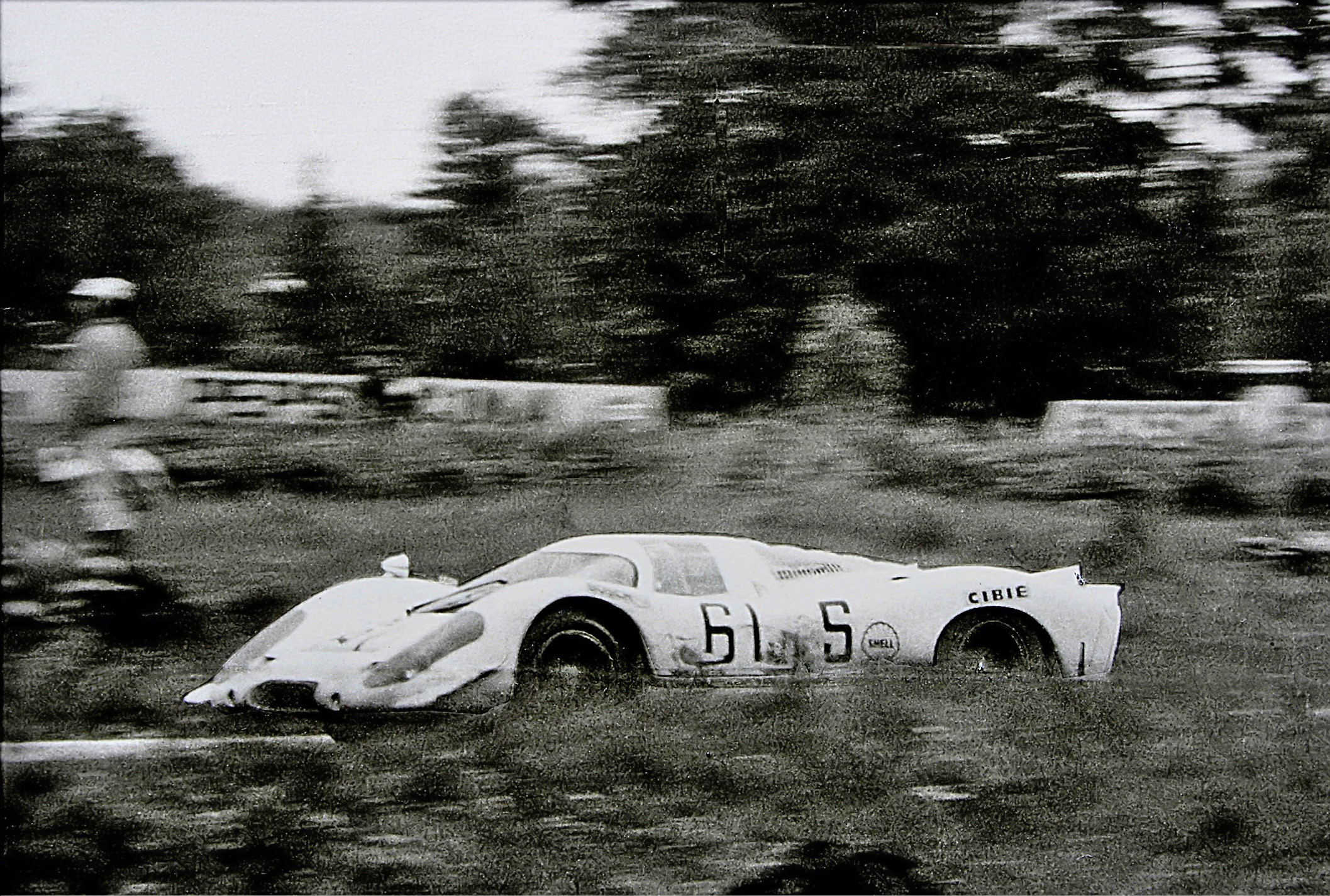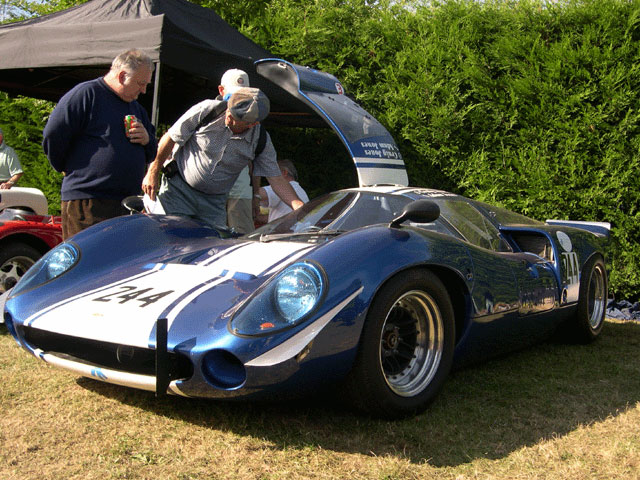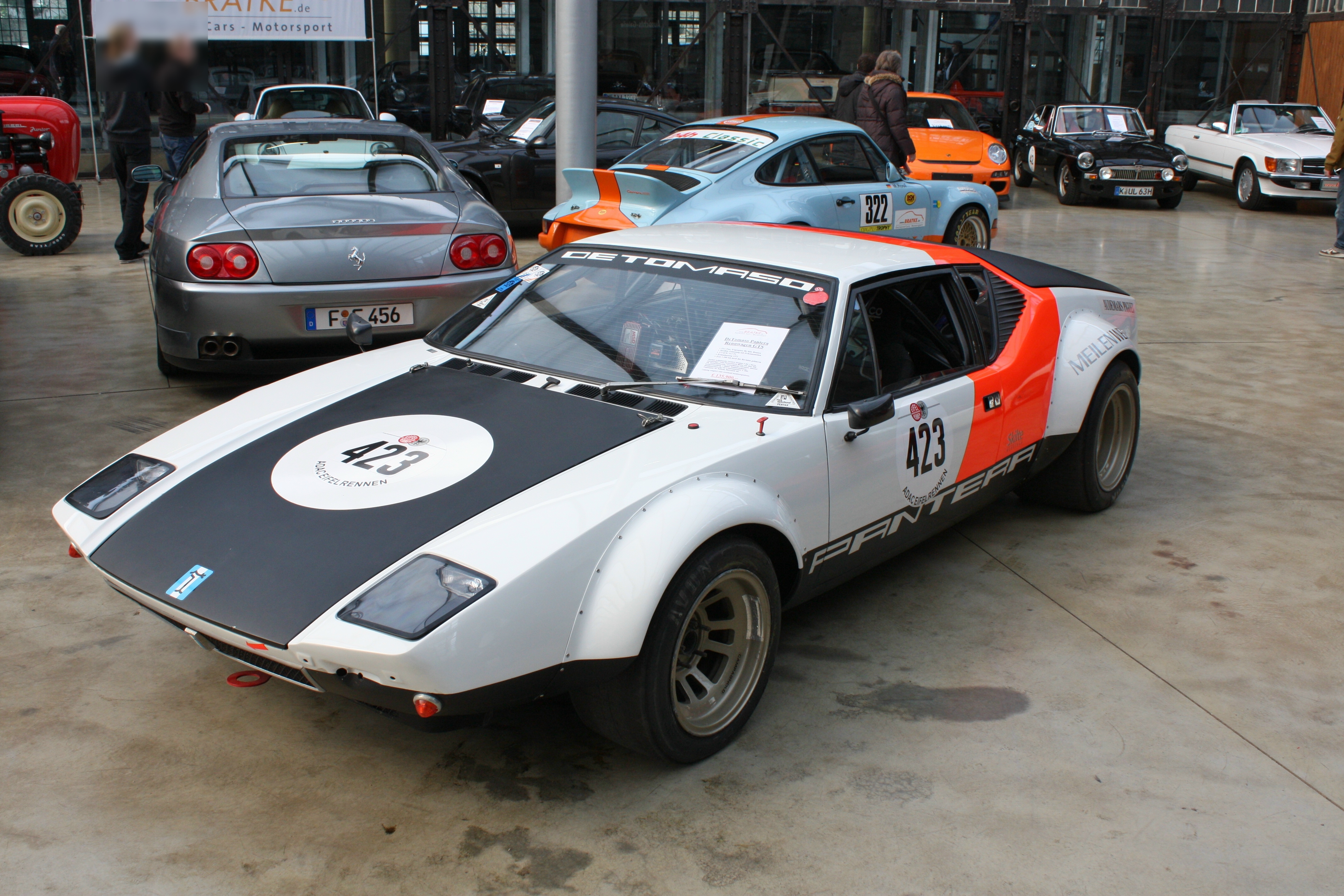|
Porsche 917
The Porsche 917 is a sports prototype race car developed by German manufacturer Porsche to exploit the regulations regarding the construction of 5-litre sports cars. Powered by a Type 912 flat-12 engine which was progressively enlarged from 4.5 to 5.0 litres, the 917 was introduced in 1969 and initially proved unwieldy on the race track but continuous development improved the handling and it went on to dominate sports-car racing in 1970 and 1971. In 1970 it gave Porsche its first overall win at the 24 Hours of Le Mans, a feat it would repeat in 1971. It would be chiefly responsible for Porsche winning the World Sportscar Championship, International Championship for Makes in 1970 and 1971. Porsche went on to develop the 917 for Can-Am racing, culminating in the twin-turbocharged 917/30 which was even more dominant in the role. Porsche drivers would win the Can-Am championship in 1972 and 1973. 917 drivers also won the Interserie championship every year from 1969 to 1975. Origin ... [...More Info...] [...Related Items...] OR: [Wikipedia] [Google] [Baidu] |
Gulf Oil
Gulf Oil was a major global oil company in operation from 1901 to 1985. The eighth-largest American manufacturing company in 1941 and the ninth largest in 1979, Gulf Oil was one of the Seven Sisters (oil companies), Seven Sisters oil companies. Prior to its merger with Chevron Corporation, Standard Oil of California, Gulf was one of the chief instruments of the Mellon family fortune; both Gulf and Mellon Financial had their headquarters in Pittsburgh, Pennsylvania, with Gulf's headquarters, the Gulf Tower, being Pittsburgh's tallest building until the completion of the U.S. Steel Tower. Gulf Oil Corporation (GOC) ceased to exist as an independent company in 1985, when it merged with Chevron Corporation, Standard Oil of California (SOCAL), with both rebranding as Chevron Corporation, Chevron in the United States. Gulf Canada, Gulf's main Canadian subsidiary, was sold the same year with retail outlets to Ultramar and Petro-Canada and what became Gulf Canada Resources to Olympia an ... [...More Info...] [...Related Items...] OR: [Wikipedia] [Google] [Baidu] |
24 Hours Of Le Mans
The 24 Hours of Le Mans () is an endurance-focused Sports car racing, sports car race held annually near the city of Le Mans, France. It is widely considered to be one of the world's most prestigious races, and is one of the races—along with the Monaco Grand Prix and Indianapolis 500—that form the Triple Crown of Motorsport, and is also one of the races alongside the 24 Hours of Daytona and 12 Hours of Sebring that make up the informal Triple Crown of endurance racing. Run since 1923, it is the oldest active Endurance racing (motorsport), endurance racing event in the world. Unlike fixed-distance races whose winner is determined by minimum time, the 24 Hours of Le Mans is won by the car that covers the greatest distance in 24 hours. The cars on this track are able to achieve speeds of , and reached on the Mulsanne Straight 1988 24 Hours of Le Mans#Statistics, in 1988instigating the addition of more chicanes to the track to reduce speed reached. Racing teams must balance th ... [...More Info...] [...Related Items...] OR: [Wikipedia] [Google] [Baidu] |
Porsche 911
The Porsche 911 model series (pronounced ''Nine Eleven'' or in ) is a family of German two-door, high performance Rear-engine design, rear-engine sports cars, introduced in September 1964 by Porsche, Porsche AG of Stuttgart, Germany. Now in its eighth generation, all 911s have a rear-mounted flat-six engine, and usually 2+2 (car body style), 2+2 seating, except for special 2-seater variants. Originally, 911s had Air-cooled engine, air-cooled engines, and torsion bar suspension, but the 911 has been continuously enhanced, and evolved across generations. Though the 911 core concept has remained largely unchanged,Corlett, p. 12 water-cooled engines were introduced with the Porsche 996, 996 series in 1998, and front and rear suspension have been replaced by Porsche-specific MacPherson strut, MacPherson suspension up front, and independent multi-link rear suspension. The 911 has been raced extensively by private and factory teams, in a variety of classes. It is among the most succes ... [...More Info...] [...Related Items...] OR: [Wikipedia] [Google] [Baidu] |
Geneva
Geneva ( , ; ) ; ; . is the List of cities in Switzerland, second-most populous city in Switzerland and the most populous in French-speaking Romandy. Situated in the southwest of the country, where the Rhône exits Lake Geneva, it is the capital of the Canton of Geneva, Republic and Canton of Geneva, and a centre for international diplomacy. Geneva hosts the highest number of International organization, international organizations in the world, and has been referred to as the world's most compact metropolis and the "Peace Capital". Geneva is a global city, an international financial centre, and a worldwide centre for diplomacy hosting the highest number of international organizations in the world, including the headquarters of many agencies of the United Nations and the International Committee of the Red Cross, ICRC and International Federation of Red Cross and Red Crescent Societies, IFRC of the International Red Cross and Red Crescent Movement, Red Cross. In the aftermath ... [...More Info...] [...Related Items...] OR: [Wikipedia] [Google] [Baidu] |
Ford P68
The Ford P68, also commonly known as the Ford 3L GT or F3L, is a sports prototype racing car model introduced in March 1968. It was designed by Len Bailey, a Ford research engineer, funded by Ford Europe and built by Alan Mann Racing at Weybridge, Surrey, UK. The first competition appearance of a Ford 3L prototype was at the BOAC 500 race at Brands Hatch in Kent. It delivered a good pace, but was criticized for instability at high speeds. It did not finish any of the races in which it was entered, due to mechanical and electrical failures. For the 1969 season the P68 was used as the basis for an aborted, fully open Spyder, dubbed the Ford P69. The P69 sported large, free-standing aerofoil wings, which were vital to the car's stability at high-speeds. However, these were banned by the European sanctioning body early in the season, thus the P68 was not eligible to race in the respective class any longer. Background At the end of the 1967 season the FIA redrew the rules for ... [...More Info...] [...Related Items...] OR: [Wikipedia] [Google] [Baidu] |
Lola T70
The Lola T70 is a sports prototype developed by British manufacturer Lola Cars in 1965, the successor to its Mk6. Lola built the aluminium monocoque chassis, which were typically powered by large American V8s. The T70 was quite popular in the mid to late 1960s, with more than 100 examples being built in three versions: an open-roofed Mk II spyder, followed by a Mk III coupé, and finally a slightly updated Mk IIIB. The T70 was replaced in the Can-Am series by the lighter Lola T160. History Early success for the Lola T70 came when Walt Hansgen won the Monterey Grand Prix, at Laguna Seca Raceway, on 17 October 1965, driving John Mecom's Lola T70-Ford. In 1966, the hot setup for the Can-Am was a T70 Chevrolet, winning five of six races during the year. John Surtees was the champion and Dan Gurney drove the only Ford powered car ever to win a Can-Am race. In 1967, no one could compete with the new M6 McLaren. When the FIA changed the rules for sports car racing for the 1 ... [...More Info...] [...Related Items...] OR: [Wikipedia] [Google] [Baidu] |
Group 4 (racing)
Group 4 referred to regulations for sportscars and Grand tourer, grand touring (GT) cars used in sportscar racing, racing and rallying, as regulated by the Fédération Internationale de l'Automobile, FIA. The group was introduced in 1954 and was replaced by Group B for the 1982 season. Production requirements Prior to 1966, the FIA's Group 4 classification applied to Sports Cars which were in compliance with FIA Appendix C regulations. It also included recognised Series Touring Cars, Improved Touring Cars and Grand Touring Cars which had been modified beyond the respective Group 1, Group 2 or Group 3 regulations under which they had been homologation (motorsport), homologated. In 1966, an overhaul of FIA categories saw Group 4 Sports Cars redefined such that they were now subject to a minimum production requirement of 50 units in 12 consecutive months and had to be fitted with all equipment necessary for use on public roads. A 5000cc engine capacity limit was applied for 1968 ... [...More Info...] [...Related Items...] OR: [Wikipedia] [Google] [Baidu] |
Commission Sportive Internationale
In-Commission or commissioning may refer to: Business and contracting * Commission (remuneration), a form of payment to an agent for services rendered ** Commission (art), the purchase or the creation of a piece of art most often on behalf of another * A contract for performance or creation of a specific work * Commissioning (other), a process or service provided to validate the completeness and accuracy of a project or venture Government Civil * A government agency, regulatory agency or statutory authority which operates under the authority of a board of commissioners, including: ** Independent agencies of the United States government *An executive branch of government, often with characteristics of other branches of government: ** Town commissioners, elected local government bodies established in urban areas in Ireland in the 19th century ** City commission, a form of local government (common in the United States) ** The European Commission, a body incorporating featur ... [...More Info...] [...Related Items...] OR: [Wikipedia] [Google] [Baidu] |
Ferrari P
The Ferrari P was a series of Italian sports prototype racing cars produced by Ferrari during the 1960s and early 1970s. Although Enzo Ferrari resisted the move even with Cooper dominating F1, Ferrari began producing mid-engined racing cars in the early 1960s with the Dino-V6-engine Formula One Ferrari 246 P and the sport prototype SP-series. The V12 sports car racers followed in 1963. Although these cars shared their numerical designations (based on engine displacement) with road models, they were almost entirely different. The first Ferrari mid-engine road car did not arrive until the 1967 Dino 206 GT, and it was 1971 before a Ferrari 12-cylinder engine was placed behind a road-going driver in the 365 GT4 BB. 250 P Ferrari produced the 250 P in 1963 in response to the FIA introducing a prototype class for the upcoming season of the World Sportscar Championship. This was a new design, with a chassis unrelated to existing 250-series Grand Touring cars. Designed by Mauro ... [...More Info...] [...Related Items...] OR: [Wikipedia] [Google] [Baidu] |
Ford GT40
The Ford GT40 is a high-performance mid-engined racing car originally designed and built for and by the Ford Motor Company to compete in 1960s European endurance racing. Its specific impetus was to beat Scuderia Ferrari, which had won the prestigious 24 Hours of Le Mans race for six years running from 1960 to 1965. Around 100 cars have been made, mostly as V8-powered Mk Is, some sold to private teams or as road-legal Mk III cars. The car debuted in 1964, with Ford winning World Championships categories from 1966 to 1968. The first Le Mans win came in 1966 with three powered Mk.II prototypes crossing the finish line together, the second in 1967 by a similarly powered highly modified US-built Mk.IV "J-car" prototype. In order to lower ever-higher race top speeds, a rule change from 1968 onwards limited prototypes to 3.0 litre Formula 1 engines; a loophole, however, allowed the private JW "Gulf Oil" team to win at Le Mans in 1968 and 1969 running a Mk.I with a 5.0 litre engi ... [...More Info...] [...Related Items...] OR: [Wikipedia] [Google] [Baidu] |
Group 6 (racing)
Group 6 was the official designation applied by the FIA to two motor racing classifications, the Prototype-Sports Car category from 1966 to 1971 and the Two-Seater Racing Cars class from 1976 to 1982. Group 6 Prototype-Sports Cars (1966 to 1971) The original Group 6 was introduced for the 1966 racing season, at the same time as a new Group 4 Sports Car category. Whilst Group 4 specified that competing cars must be one of at least fifty examples built, Group 6 had no minimum production requirement. Nor did it have a maximum engine capacity limit although there were weight, dimensional and other restrictions placed on the Group 6 cars.M.L Twite, The World’s Racing Cars, 4th Edition, 1970, Page 136 The Prototypes and Sports Cars categories each had their own international championships to fight for but many of the major international endurance races such as the 24 Hours of Le Mans would count as qualifying rounds for both championships. 1968 saw a three-litre engine capacity li ... [...More Info...] [...Related Items...] OR: [Wikipedia] [Google] [Baidu] |







